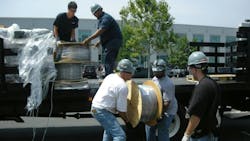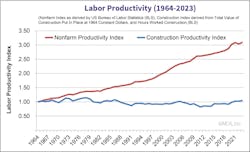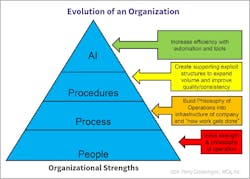The Future of Artificial Intelligence in the Construction Industry
When it comes to building efficiency within any system, the deciding factor lies not in the tools themselves but in how we leverage them to do more with less. The automation of routine or monotonous tasks frees us to focus on work that truly demands human creativity, problem-solving, and skill. This principle is already playing out in construction — where forward-thinking companies are embracing prefabrication by offloading low-skill tasks to inexperienced laborers so that professionals can concentrate on higher demanding responsibilities.
Consider how Steve Jobs once described the relationship between humans and technology. Inspired by a study that showed that a human on a bicycle is the most mechanically efficient species, Jobs famously said, “For me, a computer has always been a bicycle of the mind.” Computers were once feared as job killers, just as artificial intelligence (AI) is today. Jobs envisioned them as tools to amplify human potential. The use of Agile Intelligence® offers a more accurate term for AI in this context and represents the next iteration of that vision. Like the bicycle, it doesn’t move forward without human effort, but when used properly, it helps us move faster, farther, and smarter.
The past state of the construction industry
Historically, the construction industry has been high in tacit knowledge — that is, information rooted in personal experience, intuition, and informal training. While valuable, this form of knowledge is difficult to document, teach, or scale. Learning traditionally happens through one-on-one training, where seasoned professionals pass down their insights in ad hoc and inconsistent ways. This approach slows progress and limits efficiency, especially when skilled workers retire or change jobs without transferring their knowledge.
Moreover, several critical inefficiencies have long plagued the industry:
- Trade interference: Overlapping tasks cause delays and rework.
- Labor mismanagement: Understaffed or overstaffed crews.
- Material handling and procurement delays: Key materials are missing or improperly managed.
- Labor loading errors: Productivity gaps emerge when manpower is not aligned with the project demands.
At the root of these problems lies low codification. A lack of consistent documentation and data systems that can transform human insight into repeatable processes.
The current state: shifting toward codification
Fortunately, the construction industry is beginning to evolve. Knowledge is becoming more explicitly captured in documents, platforms, and tools that allow it to be shared more broadly. Prefabrication has already made significant strides in optimized material handling and procurement processes, proving that once taboo methods can deliver real value.
Prefab is no longer a buzzword; it’s a proven strategy. The challenge now lies in extending similar efficiencies into other areas still lagging, such as labor loading, planning, time management, and knowledge transfer. These are areas where experience-based decision-making has traditionally reigned and where systems are only now beginning to mature.
Labor productivity in construction has stayed stagnant over the last several decades, as seen in Fig. 1, while other industries have adapted their use of data and processes to improve productivity. With the correct use of data and proper codification, as seen in Fig. 2, the construction industry has the same potential to see increased productivity similar to industries like farming and manufacturing.
Artificial intelligence
The term artificial means that the data is being used to make predictions or recognize a pattern. So just like how humans make decisions based on historical data and patterns, AI uses the collected data to predict the outcome and the projected patterns. So, for example, take the tacit knowledge that an estimator has gathered over the years. How would you gather and protect that knowledge to ensure better estimates and winning capabilities for the companies using the tacit knowledge?
This is where AI comes in. If you can capture the results of the estimates the estimator has done over the years and feed it to the AI agent, it can predict and use the data to improve estimating accuracy and outcome. It isn’t about replacing workers or automating them out of a job. Instead, it’s about using data and computations to make people more effective by augmenting their decision making and extending their reach, as illustrated in Fig. 3.
Jobs’ bicycle analogy applies perfectly here: AI is a tool, not a rider. It doesn’t move on its own. It needs purpose, direction, and input, all of which come from humans. When used wisely, it dramatically improves the terrain on which we travel.
Unlike a buzzword, AI is built on quantified data and real numbers drawn from real world processes. However, AI is only as good as the data it’s given. If biased or incomplete data is fed into the system, its recommendations will reflect those flaws. That’s why human oversight remains essential. We choose the inputs, shape the models, and determine what outcomes we value.
How it works: from data to decisions
Good data leads to actionable insights. AI draws from multiple sources to form a reliable picture of what’s happening and what should happen next. These data sources include:
- Field observations (job-site conditions, productivity metrics).
- Accounting records (actual cost vs. budgeted cost).
- Estimations (projected material, labor, and time needs).
Platforms that can give the contractor the data needed to feed an AI agent (e.g., accounting, estimating, or productivity systems) offer insight into the progress of the job, labor productivity, and performance. The accounting data provides a financial lens, tying productivity and cost together. Integration between project managers and field personnel ensures that data flows both ways.
By triangulating this data, AI helps project teams identify problems early and propose targeted solutions. It might flag a labor shortage on a specific job, recommend crew reallocations, or suggest that a phase of work is falling behind due to trade stacking. Over time, the system learns what success looks like and helps you replicate it.
Digitizing the industry
One of the clearest paths to digitizing construction is through systematically capturing the tacit knowledge in the form of digitalized data. AI leverages these systems to identify persistent inefficiencies and generate forecasts, such as when labor demand will outpace supply or when procurement delays will impact scheduling. With proper implementation, companies can digitize everything from scheduling to bidding, labor loading, and profitability forecasting. This makes the business more agile, responsive, and capable of managing complexity in ways that traditional methods simply cannot match.
AI is not a far-off concept. The potential in transforming industries like finance, logistics, and customer service is very real and just over the horizon. It is beginning to find its foothold in construction, proving to be just as impactful as the implementation of computers decades ago.
The bicycle didn’t replace walking — it made it faster and more efficient. Similarly, AI won’t replace human judgment or creativity. It supercharges them. It helps professionals make faster, smarter decisions with a clearer view of the road ahead.
The benefits are already tangible and include:
- Smarter scheduling.
- More accurate bidding.
- Balanced labor loading.
- Increased profitability through better forecasting.
For the construction industry, the message is clear: This isn’t about replacing the worker. It’s about elevating them. We’re not building a future without people. Instead, we are building a future where people have better tools. So, the next time someone asks whether AI is coming for construction jobs, you can tell them, “No, but it’s definitely coming to make them better.” It’s time to stop fearing the bike and start riding it.



